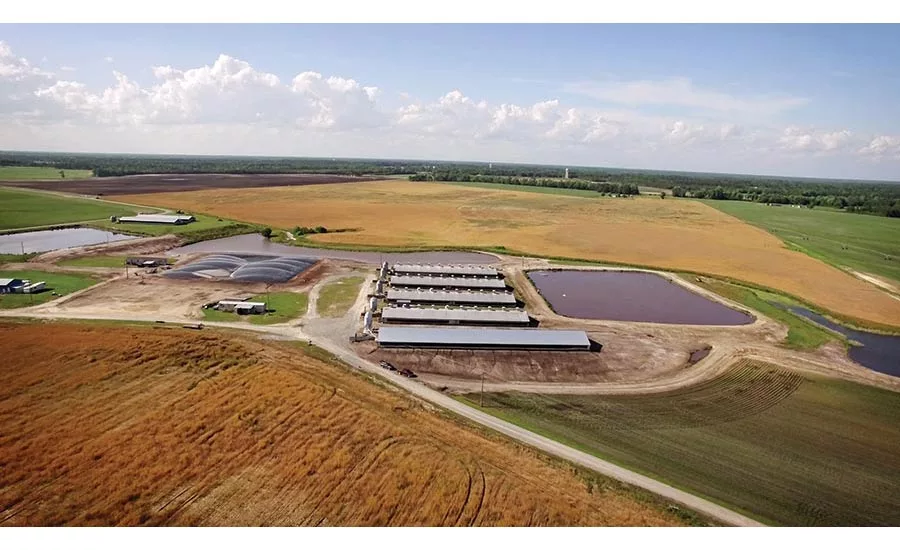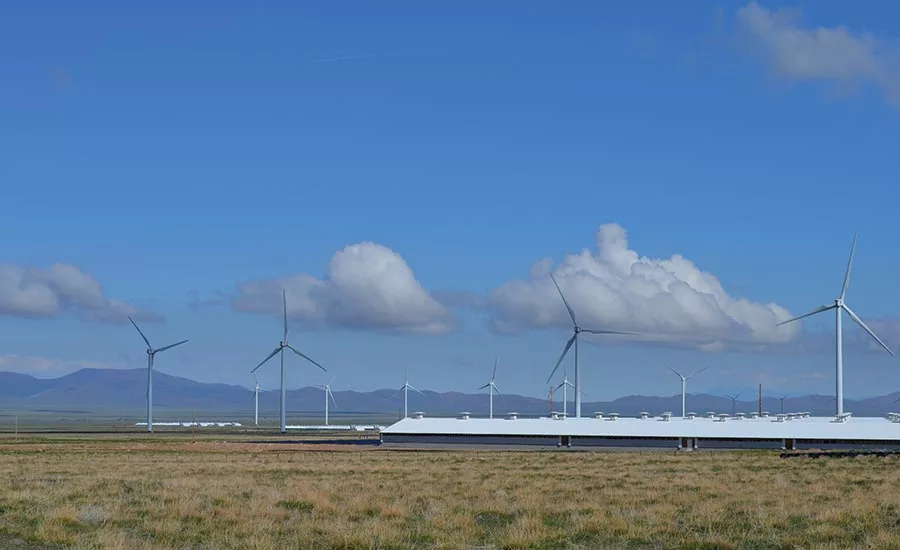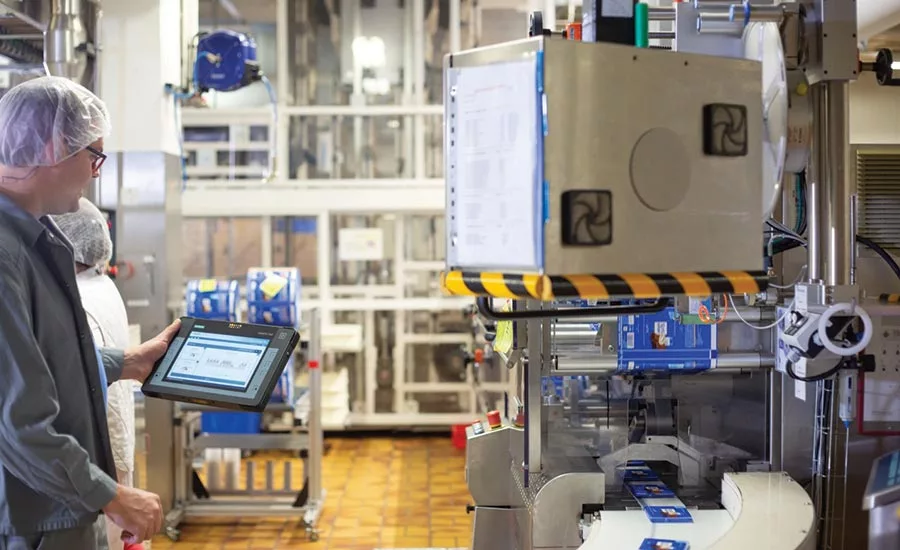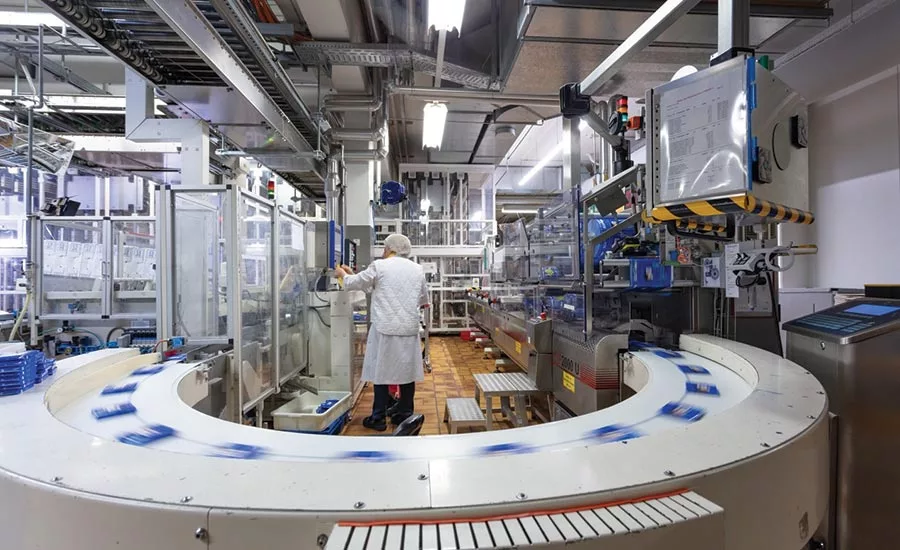Green Series
Energy Efficiency Strategies for Food Processors

A Smithfield contract hog farm participating in the Optima KV project to transform manure into renewable energy in North Carolina.
Photo courtesy of Smithfield Foods

This photo shows a Springfield, Mo., Smithfield biogas facility and hog farms (background). The biogas facility on the Smithfield hog farm cleans the methane gas and converts it into RNG.
Photo courtesy of Smithfield Foods

Smithfield’s renewable energy efforts in Utah include manure-to-energy, solar and wind projects.
Photo courtesy of Smithfield Foods

Ritter Sport employees can access all energy and production data at any time.
Photo courtesy of Siemens

Sustainability all the way to packaging: Ritter Sport is considered an example for an entire value chain that’s sustainably designed.
Photo courtesy of Siemens
While food processors have to commit to using a certain amount of energy to meet production and food safety requirements, there are ways to be more efficient about how that energy is used. Whether it’s on the production line or converting waste into power, here’s a look at how some processors are finding new ways to be more efficient with energy.
Article Index:
Smithfield’s biogas program
Smithfield Foods began its program to create biogas from plant waste even before Food Engineering awarded it Sustainable Processor of the Year in November 2014.
Today, not only does Smithfield actively create biogas from many of its processing facilities, it also has an active program to convert manure to biogas at its hog farms. Manure-to-energy projects are part of the Smithfield Renewables program, the company’s platform that unifies and accelerates its renewable energy efforts to help meet its goal to reduce greenhouse gas (GHG) emissions by 25% by 2025. Smithfield has also set up wind farms and solar collectors in some of its locations.
During this past summer, Smithfield has been busy with manure-to-energy projects in Missouri and Utah—and with the largest to date in North Carolina, where Smithfield is partnering with Dominion Energy to create enough energy to power more than 3,500 homes annually.
In Northern Missouri, Smithfield finished construction of a low-pressure natural gas transmission line connecting a Smithfield hog farm with the city of Milan. Renewable natural gas (RNG) produced at the hog farm is injected into the natural gas transmission line flowing into the city’s natural gas distribution system prior to delivery.
In a joint venture, Dominion Energy and Smithfield Foods have broken ground on North Carolina’s largest RNG venture, Align Renewable Natural Gas.
“Breaking ground on this project with Dominion Energy is an exciting first step in bringing Align RNG to life,” says Kraig Westerbeek, senior director of Smithfield Renewables and hog production environmental affairs for Smithfield Foods. “This project implements proven manure-to-energy technology across a number of farms to produce reliable renewable energy for our community and contributes to our company’s ambitions goal to reduce GHG emissions by 25% by 2015.”
Smithfield energy programs
While manure goes into anaerobic lagoons to produce methane gas, there are solids left over. I asked Westerbeek what becomes of the solids waste and found that Smithfield has an active program to deal with that too. While I had Westerbeek’s attention, I asked him a few other energy-related questions as well.
FE: What is Smithfield’s preference for the solid waste from the anaerobic digesters? Fertilizer? Or something else? What is the current state of creating fertilizer from manure?
Westerbeek: Smithfield recycles the manure produced on each company-owned farm using environmentally sound methods based on factors such as local climate, area agricultural practices and regulatory requirements. The majority of our hog farms use anaerobic lagoons to store and treat the manure before it is eventually applied as a fertilizer to grow corn, soybeans, coastal Bermuda grass and other crops that are then typically turned back into feed.
Remnant solids that accumulate over time at the bottom of anaerobic lagoons are desired by farmers as a nutrient source. To streamline the use of this material for farmers on a broader scale, we are currently working with Anuvia Plant Nutrients to utilize this material to create commercial-grade fertilizer. We’ve partnered with the North Carolina Department of Agriculture to conduct independent trials to verify that this fertilizer will improve yields for wheat crops, as it does for corn, cotton, rice and sugar beets, compared to ordinary fertilizers. Three of Smithfield’s farms are participating in these trials, and one of our agronomists is assisting in the program. These crops have been harvested, and we are evaluating them for overall yield, weight and soil quality to determine more widespread application across Smithfield’s farms.
Additionally, as part of our manure-to-energy projects, we capture biogas from hog manure that is gathered from anaerobic digesters and upgrade it to pipeline-ready renewable natural gas (RNG). The treated effluent from the digesters flows back into the existing lagoons, which creates a nutrient-rich mixture that farmers use to irrigate and fertilize their crops.
(To see another example of solids waste providing a benefit to farmers, check out the cover story in the December 2018 issue of Food Engineering.)
FE: Do Smithfield facilities use any of the RNG to power their boilers or run combined heat-power equipment to produce heat and/or electricity?
Westerbeek: We are capturing biogas from anaerobic water treatment systems at our Milan, Mo.; Grayson, Ky.; Sioux Falls, S.D.; and Tar Heel, N.C., facilities. This biogas fuels the modified steam boilers at each facility, which cuts fuel costs and reduces methane emissions. We are working on a project at our Tar Heel facility that redirects this biogas into a system that cleans and converts it into RNG to power local homes and business.
FE: What becomes of fat/lard waste from the carcasses at Smithfield processing plants? Is any of it turned into oil or biodiesel?
Westerbeek: At Smithfield, we prioritize creating the most value from our operations, which includes utilizing all parts of the hog. We render fat that results from processing and sell it to customers for a variety of purposes, such as an ingredient for animal feed, lard and other products. Some of our customers purchase fat to use in the creation of biodiesel.
FE: Do you have a waste-to-energy program where you convert waste to steam or electricity?
Westerbeek: We’ve spent decades exploring renewable energy projects on our farms and at our facilities. As one example, in 2007, we supported the development of one of the largest manure-to-electricity projects in the United States, which is located in Utah and leveraged an electricity generator as part of the refinement process. While these projects continue to operate at our Utah locations, we’ve since explored transforming manure into RNG, which yields the maximum value for our company and our stakeholders.
Additionally, in Romania, one of our meat processing facilities is capturing and reusing steam from the rendering processes onsite to heat water for meat processing, which was previously heated by natural gas.
FE: What steps do you take to conserve energy in production plants? What have been the most successful?
Westerbeek: Recent energy reduction projects in our production facilities include upgrading plant equipment and streamlining production lines to improve our processing capacity and modernize our facilities. We’ve also launched an initiative to replace metal-halide light fixtures (which are inefficient and difficult to dispose of) with LED lighting in our facilities. LED lighting uses up to 70% less electricity, can be programmed to operate at specific hours, and takes less time to turn on and off, leading to impressive energy savings. We’ve set a goal to complete this transition in five years, which is expected to produce energy savings of approximately $2 million. We are also installing occupancy sensors and low-flow water nozzles, among other efforts, to drive up production without increasing energy use.
FE: Do you have companywide contests to see which location can, for example, convert more waste to energy?
Westerbeek: We are committed to engaging our employees in our sustainability program and have implemented certification and recognition programs that encourage locations to develop innovative programs to reduce their environmental impact.
“We set a new goal to reduce solid waste to landfill 75% and achieve zero waste-to-landfill certification at 75% of our U.S. facilities by 2025. ”
– Kraig Westerbeek
One such program is our zero waste-to-landfill certification, a program under which we encourage all domestic processing facilities to meet a rigorous set of criteria in order to eliminate waste sent to landfill. Often, this includes sending waste, such as plastic, Styrofoam, rubber and food waste to local waste-to-energy facilities to generate renewable energy. This year, we set a new goal to reduce solid waste to landfill 75% and achieve zero waste-to-landfill certification at 75% of our U.S. facilities by 2025.
Additionally, we maintain an internal awards program that recognizes and rewards projects, innovations, initiatives and programs that advance sustainability throughout our supply chain. This awards program includes Environmental & Sustainability Awards, the President’s Sustainability Excellence Award, and the Zero Hero Award, which are given to facilities or teams based on environmental impact, social significance, efficiency, cost-effectiveness, originality, technical value and implementation across facilities, among other criteria. In 2018, we presented 14 facilities with these awards.
Sustainability is no game for Ritter Sport
Germany-based Ritter Sport is a can-do chocolate company that takes sustainable cocoa production seriously. How seriously? In 2012, the company purchased land in eastern Nicaragua to grow its own cocoa beans—which also gave it complete quality control of its most important ingredient. In 2018, the 87-year-old, family-run company became the first major manufacturer of chocolate bars to begin procuring all of its cocoa from certified sustainable sources.
Alfred Ritter GmbH & Co. KG received the 2018 German Sustainability Award in the midsized company category for its efforts, which also include environmentally friendly packaging. To further its sustainability efforts, the company recently declared its intention to plant 1 million trees by 2028 as part of the Plant-for-the-Planet movement.
Alfred Eugen Ritter and Clara Ritter established their chocolate and confectionery plant in Stuttgart-Bad Cannstatt, Germany. In 1932, Clara Ritter came up with the square chocolate shape, which remains a standard feature today. The business now employs 1,500 people and generated about $535 million in sales in 2017. Every day, more than 3 million chocolate bars leave the manufacturing facility in the town of Waldenbuch for export to more than 100 countries worldwide.
Good for the planet, good for the bottom line
In Germany, where electrical energy rates rank the highest in Europe and run almost three times the cost per kilowatt-hour than the average rate in the U.S. (an average of $.33 vs. $.13 per kwH) according to statista, saving energy is not only good for the environment, but also pays off on the bottom line.
To combat high energy prices, Ritter Sport has taken an active role in reducing its overall energy footprint. Since 2002, the company has operated its own combined heat and power plant. Following a renovation in 2016, the CHP plant has produced 9.9 million kilowatt hours, which covers about a third of its total power demand and 70% of its heat demand.
The company has set ambitious energy-efficiency goals, according to Eberhard Pfeifer, staff planner at Alfred Ritter GmbH: “We’ve taken it upon ourselves to cut energy consumption by 1.5% each year.” To achieve this, the company wanted a modern energy management solution that would not only meet ISO 50001 requirements but also track down hidden potentials in production. “For Ritter Sport, this is the first step toward determining how much energy goes into each individual bar of chocolate,” says Pfeifer.
The new energy management system was intended primarily to integrate all energy data from production, buildings and power generation into a single system and to store and archive the data in a central database. The new system also had to be able to link energy data with process information so Ritter Sport could determine the energy efficiency of its production practices. Finally, the new solution needed to be intuitive to operate so that the production and energy management teams could view the data at any time.
After some due diligence, Ritter Sport found a solution that met all of its criteria in Siemens Simatic Energy Manager Pro. The energy management system collects not just the data from production but also energy data from the Desigo Insight building management system. The EMS is easy to maintain and can be scaled or modified in the future without any external resources.
Ritter Sport plans to record directly the measured values with Simatic S7-1200 and S7-1500 controllers and with Simatic AI energy meters. Sentron PAC measuring devices will be installed to integrate additional measuring points.
Quick install, big payoff
Siemens supported the commissioning of the new system and trained Ritter Sport’s employees on site. The system was installed in four days, and the employees were able to work with it immediately after the training course. Since then, the EMS has met every expectation. “We were deeply impressed with the software, the training sessions, the support and the entire process of working with Siemens,” says Pfeifer.
Ritter Sport now has a system that not only lets it manage energy in compliance with ISO 50001 but also collect and link data from a wide range of sources. As a result, the company can establish a relationship between consumption values and production data to gain detailed insight into how much energy each process consumes. It can identify hidden potential and continue to increase its energy efficiency.
“With Simatic Energy Manager PRO, both the easy data management functions and the wonderful visualization capabilities fascinated us from the very beginning,” says Benjamin Flaig, energy manager at Ritter Sport. “The system delivers transparency so that we already know who the biggest consumers are, and we also know where we need to expand on things and probe deeper.”
The system provides a number of dashboards that employees can use to access energy and production data at any time and easily analyze the data. The information can be called up directly on the PCs and terminals on the shop floor or on mobile devices. “I can access the figures from anywhere, which is very convenient,” says Flaig.
Check out more Sustainability stories
The system’s versatility and ease of handling were key to Flaig’s decision early on. “I like to say that energy efficiency is a smart way to be lazy,” says Flaig. “The Simatic Energy Manager fits very well with this idea because you can really do a lot with little effort.”
Looking for a reprint of this article?
From high-res PDFs to custom plaques, order your copy today!







